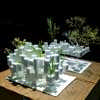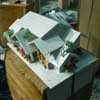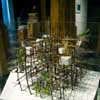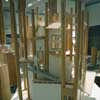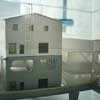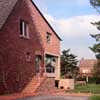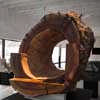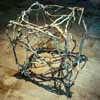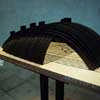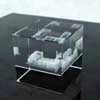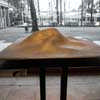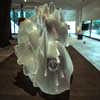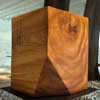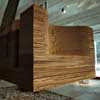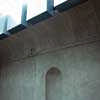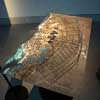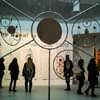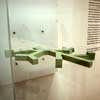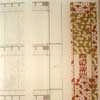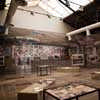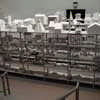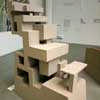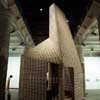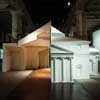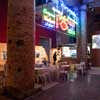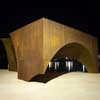Venice Architecture Biennale 2012, Exhibit, Images, Design
Venice Biennale 2012 : Architecture
Architectural Review of the Exhibits
13 Dec 2012
Venice Biennale 2012 Review
Venice Architecture Biennale Review by Gustavo Pernía
The 13th Venice Architecture Biennale, directed by David Chipperfield and titled Common Ground, closed on 25th November 2012 attracting 178,000 visitors.
Here’s a selection of some of the most interesting installations.
From Japan’s Pavilion
Toyo Ito brings together three young Japanese architects (Kumiko Inui, Sou Fujimoto and Akihisa Hirata) to collaborate in the design a “Home-for-All” for people who lost everything in the city of Rikuzentakata because of the tsunami of 2011 in the north of Japan.
Golden winning Lion for the Best National Participation, the project exudes humanity, is one of the clearest examples of real collaboration in the design process of a home.
The result transcends disaster relief architecture and gives a glimpse of what could become an architecture that embodies the desires, user daily habits and a particular comprehension of the inner logic of a place through a professional method that is willing to dilute their personality and authorship to a minimum. A future and promising path for architecture.
From Germany’s Pavilion
The Germany’s pavilion focuses its Reduce/Reuse/Recycle impeccable installation on recent works in Germany that share a particular approach to Architecture as a Resource in times of austerity. A modest but intelligent intervention that invites us to rethink the concept of green architecture and the appreciation and care of relatively recent built heritage.
A simple, clear and didactic installation, which is some relief in a biennial sometimes crowded by unprofitable information.
From Nordic’s Pavilion
Celebrating 50 years of the Nordic pavilion designed by Sverre Fehn, 32 young architects from Finland, Norway and Sweden expressed their ideas for a conceptual “Light House” that merges architectural character (site, material, tectonics, light) of the pavilion, the environmental/cultural character of the Nordic region and the core principles and techniques of every participant/practice.
The featured models seek to evoke feelings, sensory experiences and concepts, rather than objectively describe reality.
Openness, lightness, depth of experience, rest, emotional resonance, and ‘noble poverty’ comes to figure out the up-to-date assertion of an architecture identity in Nordic countries.
From Poland’s Pavilion
“Making the walls quake as if they were dilating with the secret knowledge of great powers” is a remarkable installation (Jury Special Mention) of the Polish Pavilion by the artist Katarzyna Krakowiak in which sound and space fuses into an intense atmosphere. Visitors walk near the walls, through the pavilion and experiment architecture in a rather different and peculiar way. All the sounds are live and internal to the pavilion, they have been amplified so visitors can listen, hear, eavesdrop and feel the building. It becomes a living thing, didactic, frightening and quite mysterious at the same time.
From Central Pavilion
The installation The Banality of Good –paraphrasing Hanna Arendt- by Crimson Architectural Historians presents an analysis of the New Towns evolution, a sample of six cities built from the 50’s to the present, evidence the inversion and subversion of New Towns founding ideals of emancipation, social equality and progress, where values as the “just”, the “moral” or the “good” have been abandoned and replaced by process, profit, efficiency, and expediency. From providing housing to the poor to provide comfortable and isolated urban settlements for the rich, from the pursuit of common good to the satisfaction of the desires of the few who can afford it.
A well-founded critic of the drift that has taken urban planning since the middle of last century to the present day.
The architect Juan Herreros materialize the theme of the biennale through large scale technical documents of constructive details, facade cross-sections and abstracted models of unmentioned projects, in order to illustrate his idea of Common Ground in current architectural practice, in which technique acts as amalgam of diverse disciplines and where the architect is no longer a conductor but a member of a multipolar, interdisciplinary team, also enriched by those who occupy and share the building.
The dialogue architecture: a meeting of skills, abilities, and knowledge.
The OMA installation collects works of architecture by civil servants in five european countries driven by local authorities in the 1960s and 1970s. A mix of still modern and refreshing works made for the greater good, without personal ambitions, yet excellency in teamwork without figures, reminds us a different way of practice.
A legacy made with common sense, rigor, control and optimism. A selection of humble masterpieces achieved by bureaucrats.
‘40,000 Hours’ is the estimated time that took the students to make this selection of models. Showcased as a tribute to the collective effort at schools of architecture around the world.
Same material, similar dimensions, anonymous models made individually for different projects, lets us take a look at upcoming ideas and tactics of new architects and to the state of academic practice through diverse institutions.
Winner of the Silver Lion, this installation face large scale models of the Paulo Mendes da Rocha’s Serra Dourada Stadium in Brazil and Grafton Architects’ UTEC university campus in Lima. The influence that Brazilian Pritzker prize has had on the Irish architects is revealed by the researched subjects as “built geography”, “abstracted landscape”, “landscape and infrastructure,” and “the horizon and the human being” (suggestive comparison of the landscapes of Machu Picchu in Peru and Skellig Michael off the west coast of Ireland). It also explores the possibilities of the ‘Free Section’ as a representation and work resource for big scale projects that encourage fluid, generous, open and massive spaces.
From Arsenale
Exploring the links between timber and brickwork the Irish architects Sheila O’Donnell and John Tuomey present Vessel, a wooden structure (passage, chamber and funnel) in raw dialogue with the layered brick construction of the site: the historic Arsenale, shipbuilding and archaic constructions reexamined.
A mold of Palladio’s Villa Rotunda is the center of a larger installation in which FAT architecture practice explore the concept of copying and transformation in architecture.
Ines Weizman scrutinizes the ownership disputes regarding Adolf Loos’s Baker House design. An intricate yet fascinating copyrights thriller presented through diagrams and letters.
San Rocco invites visitors to produce a library from other books photocopies.
Architectural Doppelgängers presents a series of photographs of actual architectural copies facing their respective originals. A state-of-the-art installation.
The Torre David Gran Horizonte installation –Golden Lion for best project- by Urban Think Tank studio, shows a documentary and photographs about the abandoned office building that is occupied by inhabitants of the Caracas’ favelas. An ambiguous installation that showcase a typical restaurant that could be located in the vertical slum, lends itself to multiple, varied and contradictory readings. The controversy is served, the installation and the prize was disowned both by the government of Venezuela and the association of architects in that country (autonomous and ideologically opposed).
From Gaggiandre
The Gaggiandre at the Arsenale, two docks built between 1568 and 1573 designed by Jacopo Sansovino flanked by arched walkways are the frame and inspirational source for the sculpture ‘Radix’ made by Portuguese architect Aires Mateus, an arch supported by three points and an imaginary fourth corner hanging over the Venitian Lagoon.
A harmonic place to stay and rest where history, sensitivity, technology, culture and a certain affection to the site comes into the common ground that the biennale stands for.
Finally, special mention deserves MVRDV architects alongside The Why Factory with their ‘Freeland’ video-installation. It presents a refreshing idea of urban planning in which government agencies are put aside to make way for the self-organizing ability of individuals, which have a lot of freedom but are also responsible for supplying their own needs and grant certain urban values and community services.
Will we see the DIY urbanism in the near future?
Location: Venice Biennale, Italy
Venice Architecture
Venice Architecture Designs – chronological list
Venice Architecture Walking Tours
Venice Biennale – Exhibitions, Designs, Images
Venice Biennale Croatian Pavilion 2010 – The Ship : Floating Pavilion
Venice Biennale exhibition 2007 : Dune Formations installation, Scuola dei Mercanti
Venice Biennale landscape installation : Gustafson Porter
Comments / photos for the Venice Architecture Biennale 2012 page welcome
Venice Biennale Architecture
2012Website: Visit Venice

